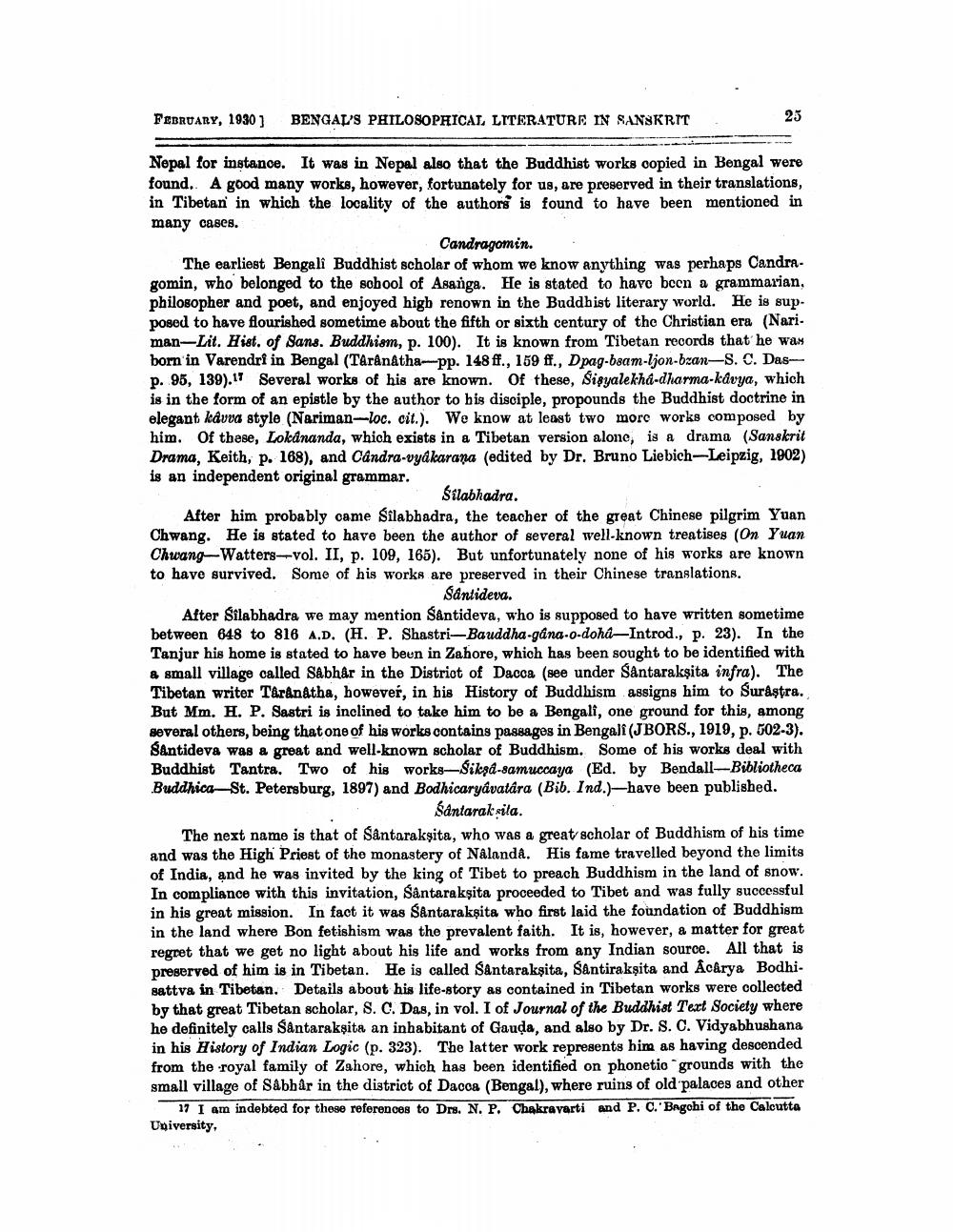________________
FEBRUARY, 1930 )
BENGAL'S PHILOSOPHICAL LITERATURE IN SANSKRIT
25
Nepal for instance. It was in Nepal also that the Buddhist works copied in Bengal were found. A good many works, however, fortunately for us, are preserved in their translations, in Tibetan in which the locality of the authors is found to have been mentioned in many cases.
Candragomin. The earliest Bengali Buddhist scholar of whom we know anything was perhaps Candragomin, who belonged to the sobool of Asanga. He is stated to have been a grammarian, philosopher and poet, and enjoyed high renown in the Buddhist literary world. He is sup. posed to have flourished sometime about the fifth or sixth century of the Christian era (Nari. man-Lit. Hist. of Sans. Buddhism, p. 100). It is known from Tibetan records that he was born in Varendri in Bengal (Taranatha pp. 148 ff., 159 ff., Dpag-bsam-ljon-bzan-S. C. Dasp. 95, 139). Several works of his are known. Of these, Sisyalekha-dharma-kavya, which is in the form of an epistle by the author to his disciple, propounds the Buddhist doctrine in elegant kávua style (Nariman-loc. cit.). We know at least two more works composed by him. Of these, Lokánanda, which exists in a Tibetan version alone, is a drama (Sanskrit Drama, Keith, p. 168), and Candra-vyákarana (edited by Dr. Bruno Liebich-Leipzig, 1902) is an independent original grammar.
Silabhadra. After him probably came Šilabhadra, the teacher of the great Chinese pilgrim Yuan Chwang. He is stated to have been the author of several well-known treatises (On Yuan Chwang-Watters--vol. II, p. 109, 165). But unfortunately none of his works are known to have survived. Some of his works are preserved in their Chinese translations.
Santideva. After Silabhadra we may mention Santideva, who is supposed to have written sometime between 648 to 816 A.D. (H. P. Shastri-Bauddha-gana-o-doha-Introd., p. 23). In the Tanjur his home is stated to have beun in Zahore, which has been sought to be identified with & small village called Sabhar in the District of Dacca (see under Santarakṣita infra). The Tibetan writer Taranatha, however, in his History of Buddhism assigns him to Surastra. But Mm. H. P. Sastri is inclined to take him to be a Bengali, one ground for this, among several others, being that one of his works contains passages in Bengali (JBORS., 1919, p. 502-3). SAntideva was a great and well-known scholar of Buddhism. Some of his works deal with Buddhist Tantra. Two of his works-Sikşd-samuccaya (Ed. by Bendall-Bibliotheca BuddhicaSt. Petersburg, 1897) and Bodhicaryavatara (Bib. Ind.)-have been published.
Santarak sila. The next name is that of Santaraksita, who was a great scholar of Buddhism of his time and was the High Priest of the monastery of Naland. His fame travelled beyond the limits of India, and he was invited by the king of Tibet to preach Buddhism in the land of snow. In compliance with this invitation, Sântarakṣita proceeded to Tibet and was fully successful in his great mission. In fact it was Santarakṣita who first laid the foundation of Buddhism in the land where Bon fetishism was the prevalent faith. It is, however, a matter for great regret that we get no light about his life and works from any Indian source. All that is preserved of him is in Tibetan. He is called Santarakṣita, Santirakṣita and Acârya Bodhi. sattva in Tibetan. Details about his life-story as contained in Tibetan works were collected by that great Tibetan scholar, S. C. Das, in vol. I of Journal of the Buddhist Text Society where he definitely calls Santarakṣita an inhabitant of Gauda, and also by Dr. S. C. Vidyabhushana in his History of Indian Logic (p. 323). The latter work represents him as having descended from the royal family of Zahore, which has been identified on phonetio grounds with the small village of Sabhar in the district of Dacca (Bengal), where ruins of old palaces and other
17 I am indebted for these references to Drs. N. P. Chakravarti and P. C. Bagchi of the Calcutta University,




